 |
 |
 |
http://www.varalaaru.com A Monthly Web Magazine for South Asian History [187 Issues] [1839 Articles] |
 |
 |
 |
http://www.varalaaru.com A Monthly Web Magazine for South Asian History [187 Issues] [1839 Articles] |
|
Issue No. 178
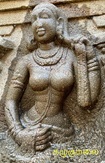
இதழ் 178 [ ஜூன் 2024 ] 
இந்த இதழில்.. In this Issue.. 
|
Srimushnam, a small town situated in the district of Cuddalore, can be found approximately 18.5 kilometers to the west of the town of Sethiathoppu. When traveling from Kumbakonam, one can reach the town by going through Solathram. On the other hand, if you are coming from Jeyankondam, the route through Andimatam will lead you to the town. The existence of the Nitheeswarar shrine, a Chola temple, is what gives this remote town its significant value. The temple is located on the eastern side of the town lying in the habited area. 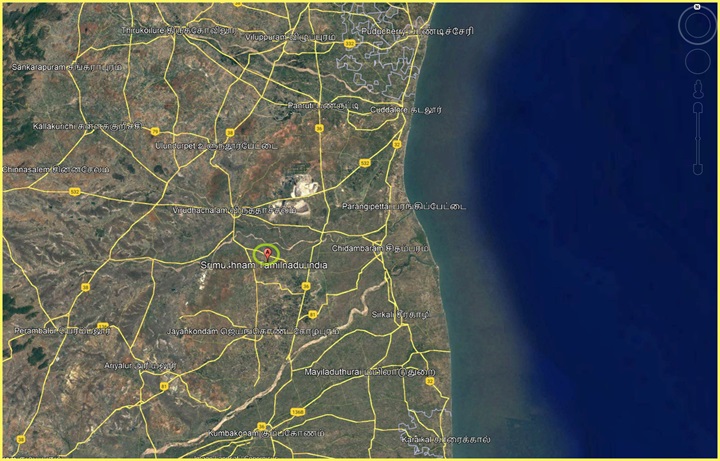 When it comes to notable places, the town of Srimushnam stands out for its incredible Bhuvaraha Perumal temple. This sacred site is of great importance to the followers of Lord Vishnu due to its dedication to him and its direct connection to his varaha avataram, which is a notable aspect of the ten incarnations famously referred to as Dasavataram. Nevertheless, it is frequently noticed that tourists who come to this area fail to fully appreciate the awe-inspiring architectural gem that is the Nitheeswarar temple, a place of reverence where devotees pay homage to Lord Siva. The location is precisely to the east, just behind the Perumal temple. 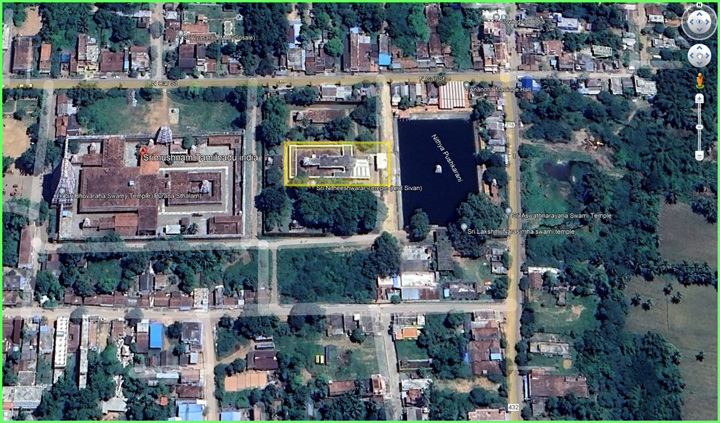 The inscriptions discovered at this site provide evidence that the construction of the temple took place approximately in 1070 CE, during the rule of the Chola kings Veera Rajendra and Kulothunga Chola I. Inscriptions found here provide evidence of the latter's rule, showcasing the separation of villages, the reduction of levies, and the continuous patronage of temples. Once upon a time, the deity residing here was recognized as the “Mahadevar of Siva Tirumuttam”, which was an indication of the name of the place in those days. The place's history and etymology are both equally intriguing and worth exploring. During the reign of Kulothunga I, this location was known by various names such as Irungolappadi, Tirumuttam, Irungolappadi Nadu, and many others. Under the reign of Kulothunga, the land was strategically divided into two regions for the purpose of taxation. A unique aspect of the temple in question is that its location was granted exemption from taxation, hence the interesting name of Sungam Thavirtha Chola Nallur. The name Tirumuttam was used for the place until the Vijayanagara Dynasty took over. Based on the temple's layout and certain inscriptions discovered, it can be strongly inferred that the initial construction of the temple solely encompassed a shrine for Lord Siva, with the Amman shrine being a distinct addition made at a later date. Additionally, this implies that the original temple predates the year 1070 CE, making it even older. Positioned towards the east, the temple not only faces that direction but also features the Nitya Pushkarini immediately to its east, serving as the Teertham for both this temple and the Bhuvaraha Perumal temple. ARCHITECTURE The main shrine, which includes a Vimana, an Antarala,Muka Mandapam and Maha Mandapam, is designed with a rather simple aesthetic. The entrance to the Muka Mandapam is beautifully adorned with two dwarapalakas, each designed in a unique and distinctive manner. 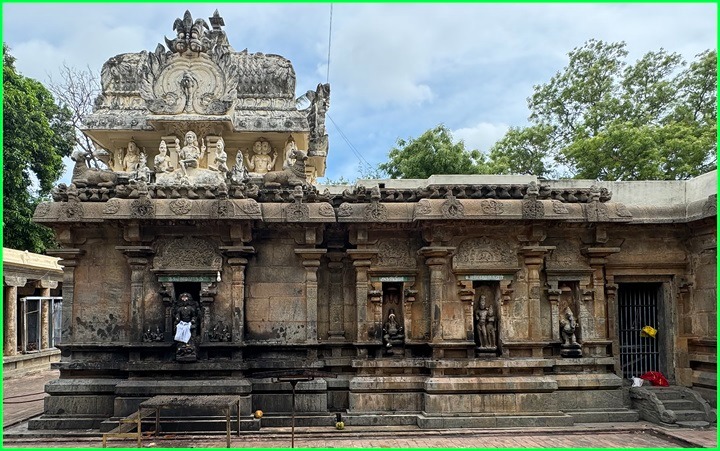 The architectural design of this structure is characterized by a single tier Nagara vimana with Nagara sikhara. A notable feature of the vimana is its padabandha adhishthana, which includes the bhitti divided into sections using Karna-Sala-Karna segmentations. Furthermore, the Sala is prominently displayed and has Sala koshthas positioned on the eastern, northern, and southern sides. In Mukamandapa Sala and karna has kosthas on either side. The combination of Vimana and Mukamandapa results in a grand total of nine koshthas. 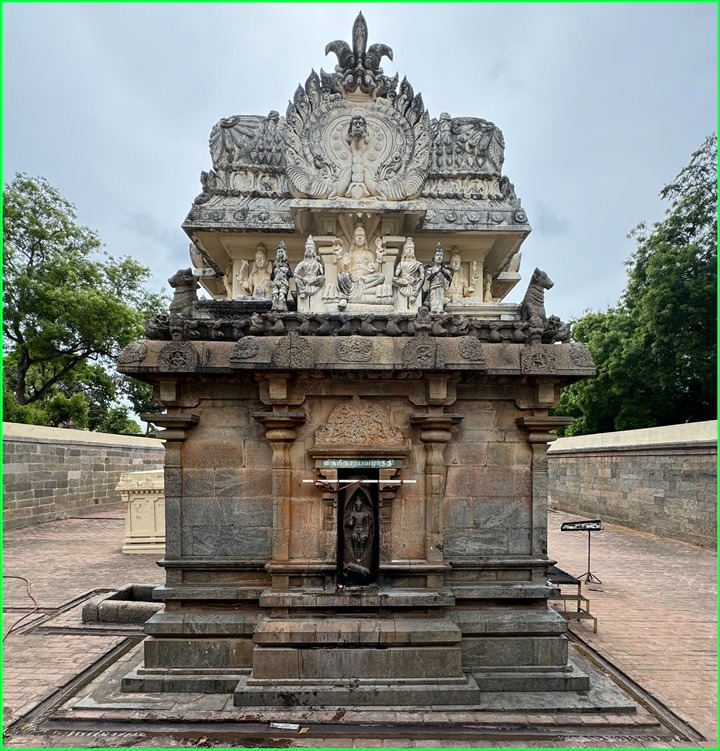 The adhishthana is adorned with various elements such as Upanam, Jagati, octagonal kumuda, kantha flanked by kampas, and intersecting padas and pattika. Positioned above the pattika Vedika, there are kampas on either side with intersecting padas. The wall, which is slightly inside, is raised on the upari kampa situated above the vedika. The vimana is divided into sections by a total of four pilasters, with two brahmakantha pilasters positioned at the corners and two vishnukantha pilasters in the middle, which are flanking the Sala koshthas. The pilasters are adorned with various dilapidated upper ornamentations, including mala, sthana, kattu, kalasa, tadi, kumbha, pali, phalaka, and virakantha. The potikas, which are situated above the pilasters, feature angular taranga and are adorned with a median patta. Instead of extending to the entire arms of the potikas, the tarangas flatten out as they reach the uttira. The potikas are adorned with arms that bear the uttira, and positioned above them are the vajana and valabhi. The valabhi is enhanced by the intricate bhuta series that adorns it. The vimana's roof extends in every direction, creating an overhanging kapota effect. In the design of the kapota, the kudus are meticulously placed to match the position of the pilasters, and the ridges are embellished with depicted chandramandalas. The kapota is adorned with decorative elements that are visible at its corners. The bhumidesa, positioned above the roof, is used to represent the end of the tala. The bhumidesa showcases the bold yazhis as frieze, with the added feature of makara heads projecting at the corners. The kudus, which are found on the face of the kapota, are intricately crafted using miniature sculptures. The Antarala, a space that separates the Vimana and Mukamantapa, features a beautifully adorned decorative pilaster. On either side of the Mukamandapa koshthas, there are pilasters of the brahmakantha type, mirroring the features observed on the pilasters of the vimana wall in the Karna segmentations. The Mukamandapa features walls that are divided by two brahmakantha pilasters positioned at the corners, as well as two vishnukantha pilasters in the middle, which flank the Sala koshthas. Above all the nine koshtas, the Makara thorana stands tall and can be seen clearly. The finishing touches have been applied to the Nagara shikara, using a modern plastering method. Utira, vajana, and valabi are used to adorn the long griva, enhancing its overall beauty. The Griva Gosthas, also known as the neck regions, are decorated with the divine figures of Brahma, Vishnu, and Dakshnamoorthy, representing the cardinal directions. On the roof, Nandi is depicted seated at each of the four corners. The Gosthas having Vinayakar, Uma Maheswarar, Agastyar, Dakshinamurti, Lingodhbhavar, Brahma, Ardhanareeswarar, and Durgai, all of which have been meticulously sculpted. The ninth Sculpture holds intrigue as it is an inexplicable and unidentified mass of stone. |

சிறப்பிதழ்கள் Special Issues 

புகைப்படத் தொகுப்பு Photo Gallery 
|
| (C) 2004, varalaaru.com. All articles are copyrighted to respective authors. Unauthorized reproduction of any article, image or audio/video contents published here, without the prior approval of the authors or varalaaru.com are strictly prohibited. | ||